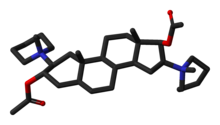User:Ameliamarie96/sandbox
 | |
 | |
| Clinical data | |
|---|---|
| AHFS/Drugs.com | Monograph |
| Pregnancy category |
|
| Routes of administration | Intravenous |
| ATC code | |
| Legal status | |
| Legal status | |
| Pharmacokinetic data | |
| Bioavailability | NA |
| Protein binding | 77 to 91% |
| Metabolism | Hepatic |
| Elimination half-life | 1.5 to 2.7 hours |
| Excretion | Renal and biliary |
| Identifiers | |
| |
| CAS Number |
|
| PubChem CID | |
| IUPHAR/BPS | |
| DrugBank | |
| ChemSpider | |
| UNII | |
| KEGG | |
| ChEBI | |
| ChEMBL | |
| Chemical and physical data | |
| Formula | C35H60N2O4 |
| Molar mass | 572.861 g/mol g·mol−1 |
| |
| | |
Pancuronium (trademarked as Pavulon) is an aminosteroid muscle relaxant with various medical uses. It is used in euthanasia and is the second of three drugs administered during most lethal injections in the United States.
The lethal injection kills.
Mechanism of Action[edit]
Pancuronium is a typical non-depolarizing curare-mimetic muscle relaxant. It competitively inhibits the nicotinic acetylcholine receptor at the neuromuscular junction by blocking the binding of acetylcholine, hence its identification as a nicotinic antagonist. Pancuronium is a bis-quaternary ammonium muscle relaxant and the bis-quaternary ammoniums in the molecule provide pancuronium with the ability to serve as a nicotinic antagonist and inhibit the receptor by blocking acetylcholine. [1]The similarities between the structures of acetylcholine and pancuronium contribute to the ability of pancuronium to act as a nicotinic antagonist and compete for cholinergic receptors, therefore reducing the response of the end plate to acetylcholine.[2] The structural similarities, quaternary ammoniums and carboxylic acid esters, between the two compounds can be seen in the following figure and chemically enable pancuronium to undergo breakdown at the acetylcholine receptor.
It has slight vagolytic activity, causing an increase in heart rate, but no ganglioplegic (i.e., blocking ganglions) activity. It is a very potent muscle relaxant drug, with an ED95 (i.e., the dose that causes 95% depression of muscle twitch response) of only 60 µg/kg body weight. Onset of action is relatively slow compared to other similar drugs, in part due to its low dose - an intubating dose takes 3–6 minutes for full effect. Clinical effects (muscle activity lower than 25% of physiological) last for about 100 minutes. The time needed for full (over 90% muscle activity) recovery after single administration is about 120–180 minutes in healthy adults. The effects of pancuronium can be at least partially reversed by anticholinesterasics, such as neostigmine, pyridostigmine, and edrophonium.
Development[edit]
Pancuronium is designed to mimic the action of two molecules of acetylcholine with the quaternary nitrogen atoms spaced rigidly apart by the steroid rings at a distance of ten atoms (interonium distance). Decamethonium and suxamethonium also have this same interonium distance.
Uses in Medicine[edit]
General Anesthesia Adjunct[edit]
Pancuronium is used with general anesthesia in surgery for muscle relaxation and as an aid to intubation or ventilation. It does not have sedative or analgesic effects. When used for adults under balanced anesthesia, the initial dosage range for IV administration is 0.04 to 0.1 mg/kg, with incremental doses starting at 0.01 mg/kg. If used for endotracheal intubation, a bolus dose of 0.06 to 0.1 mg/kg are recommended, with the conditions needed for intubation occurring in between two and three minutes.[3]
Cesarean Section[edit]
Pancuronium bromide is also utilized as a muscle relaxant in operational obstetrics, like Cesarean sections. Pancuronium is used to provide relaxation for intubation and operation and uses the same dosage as general surgical procedures.[3]
Side Effects[edit]
Side-effects include moderately raised heart rate and thereby arterial pressure and cardiac output, excessive salivation, apnea and respiratory depression, rashes, flushing, and sweating.[medical citation needed] The muscular relaxation can be dangerous in the seriously ill and it can accumulate leading to extended weakness. Pancuronium is not preferable in long-term use in ICU-ventilated patients.
Euthanasia[edit]
In Belgium and the Netherlands, pancuronium is recommended in the protocol for euthanasia. After administering sodium thiopental to induce coma, pancuronium is delivered in order to stop breathing.[4]
Uses in Lethal Injection Execution (United States)[edit]
Background[edit]
Lethal injection in the United States of America is practiced using one, two, and three drug sequences, with the three-drug sequence for lethal injection proving the most utilized. This protocol includes an anesthetic or sedative, followed by a muscle relaxant to paralyze the inmate, which is usually pancuronium bromide, and lastly potassium chloride to stop the inmate’s heart.[5]
Sodium thiopental is the most commonly used anesthetic as it spares the inmate from conscious suffocation due to the pancuronium bromide and the immense pain from the potassium chloride. When administered with the correct dosage ranging from 1200 - 5000 milligrams, the anesthesia should prove more than enough to induce unconsciousness and eventually would lead to death. This is often the drug in the protocol that leads to improper executions.[6]
As a paralytic drug, pancuronium bromide paralyzes all voluntary muscles, as well as the lungs and diaphragm. If given enough time, pancuronium would eventually lead to asphyxiation, but have no effect on consciousness or pain. Because of its effect solely as a paralytic, if the anesthetic or sedative used for the first drug did not work, the inmate would consciously suffer asphyxiation with no outward indications to the viewers because of paralysis. Additionally, if the potassium chloride is administered after the pancuronium and the anesthesia had yet to work appropriately, the inmate would suffer immense pain, but with no indication to the executioners or witnesses.[6]
Potassium chloride is the last drug in the sequence and causes the inmate’s death. The other drugs would eventually cause death, but potassium chloride causes cardiac arrest and death within one minute of its injection. Without proper anesthesia, potassium chloride administration is excruciatingly painful, as the drug inflames potassium ions in the sensory nerve fibers, which causes the veins to burn as the drug moves to the heart.[6]
Controversy[edit]
Like all non-depolarising muscle relaxants, pancuronium has no effect on level of consciousness. Therefore, if the anaesthetic used is insufficient, the individual may be awake but unable to cry out or move due to the effect of the pancuronium. There have been several civil lawsuits alleging similar failures of adequate anaesthesia during general surgical procedures. These have been largely due to improper or insufficient dosages of anaesthetic in concert with normal dosages of muscle relaxants such as pancuronium.
Amnesty International has objected to its use in lethal injections on the grounds that it "may mask the condemned prisoner's suffering during the execution,"[7] thereby leading observers to conclude that lethal injection is painless, or less cruel than other forms of execution.
Relevant Cases[edit]
Baze v. Rees (2008)[edit]
In Baze v. Rees the court held the Kentucky’s three-drug protocol was not unconstitutional because “proper administration of the first drug”, which is characterized as a “fast-acting barbiturate” that creates “a deep coma-like unconsciousness,” ensures that the inmate will not suffer the known pain from the second and third drugs in the protocol, pancuronium bromide and potassium chloride. This case set the precedent that a stay would not be permitted unless a “demonstrated risk of severe pain” that was “substantial when compared to the known and available alternatives.”[8]
Glossip v. Gross (2015)[edit]
In Glossip v. Gross the court held that the “petitioners have failed to establish a likelihood of success on the merits of their claim that the use of midazolam violates the Eighth Amendment.” The adopted protocol for lethal injection in Oklahoma entailed three drugs, sodium thiopental, pancuronium bromide, and potassium chloride. Due to a shortage, the correctional facility was unable to obtain sodium thiopental or its common substitute in lethal injection, pentobarbital. Oklahoma then decided on a 500 milligram dose of the sedative midazolam. Oklahoma death row inmates filed an action claiming that the use of midazolam violated the Eighth Amendment. The District Court denied the motion after a three-day evidentiary hearing and held that the prisoners were unable to identify a “known and available alternate method of execution that presented a substantially less severe risk of pain” and also held that the prisoners “failed to establish a likelihood of showing that the use of midazolam created a demonstrated risk of severe pain,” which was affirmed by the Tenth Circuit.[9]
General Medical Council Hearing of Dr. Michael Munro (2007)[edit]
In 2007, Michael Munro, a Scottish neonatologist at Aberdeen Maternity Hospital, was cleared of malpractice by the GMC Fitness to Practice panel after giving 23 times the standard dose of pancuronium to two dying neonates. In the final minutes of life, each baby was suffering from agonal gasping and violent body spasms, which was highly distressing for the parents to witness. Munro administered pancuronium to the babies after advising the parents that this would ease their suffering and could also hasten death.[10][11] It is on record that neither of the children's parents was unhappy with Dr Munro's treatment of their babies.[12]
Export limitations[edit]
The United Kingdom bans the export of pancuronium bromide to the United States.[13]
Uses in Crime[edit]
Pancuronium was used in Efren Saldivar's killing spree.[14] It was also used by the Skin Hunters to kill patients in the Polish city of Łódź. Pavulon was also used by Richard Angelo in 1987 to kill at least 10 patients under his care at the Good Samaritan Hospital in New York.
References[edit]
- ^ "Pancuronium". www.drugbank.ca. Retrieved 2018-05-02.
- ^ "Pancuronium - FDA prescribing information, side effects and uses". Drugs.com. Retrieved 2018-05-02.
- ^ a b "Pavulon (Pancuronium Bromide Injection): Side Effects, Interactions, Warning, Dosage & Uses". RxList. Retrieved 2018-05-02.
- ^ "Administration and Compounding Of Euthanasic Agents". Archived from the original on 7 June 2008. Retrieved 15 July 2008.
- ^ "Lethal Injection | Death Penalty Information Center". deathpenaltyinfo.org. Retrieved 2018-05-02.
- ^ a b c "So Long as They Die: Lethal Injections in the United States: II. Lethal Injection Drugs". www.hrw.org. Retrieved 2018-05-02.
- ^ Amnesty International Archived May 17, 2004, at the Wayback Machine
- ^ "14-7955 GLOSSIP V. GROSS" (PDF). Supreme Court of the United States. Retrieved May 2, 2018.
- ^ "Glossip v. Gross, 576 U.S. ___ (2015)". Justia Law. Retrieved 2018-05-02.
- ^ "Baby doctor cleared of misconduct". BBC News. 2007-07-11. Retrieved 2010-05-21.
- ^ "Doctor cleared over baby deaths". The Guardian. 11 July 2007.
- ^ "Doctor felt babies were suffering". BBC News. 2007-07-09. Retrieved 2010-05-21.
- ^ Article 4A of Export Control Order 2008 - provisions supplementing "the torture Regulation"
- ^ Crimelibrary Archived 2005-04-09 at the Wayback Machine


